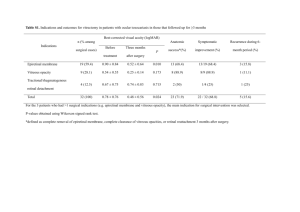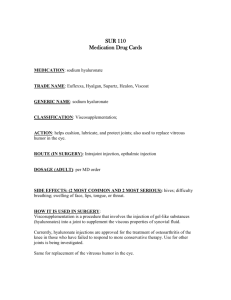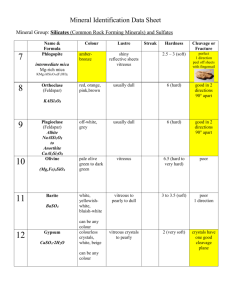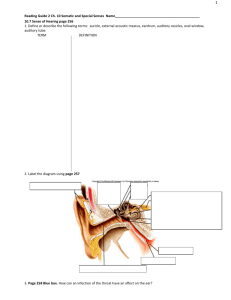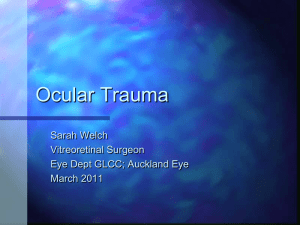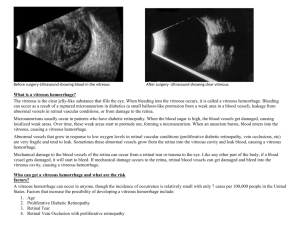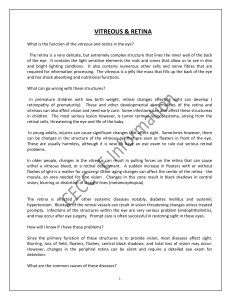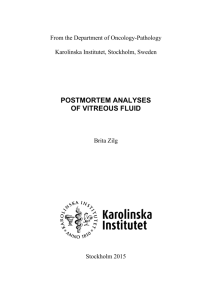Indice
advertisement
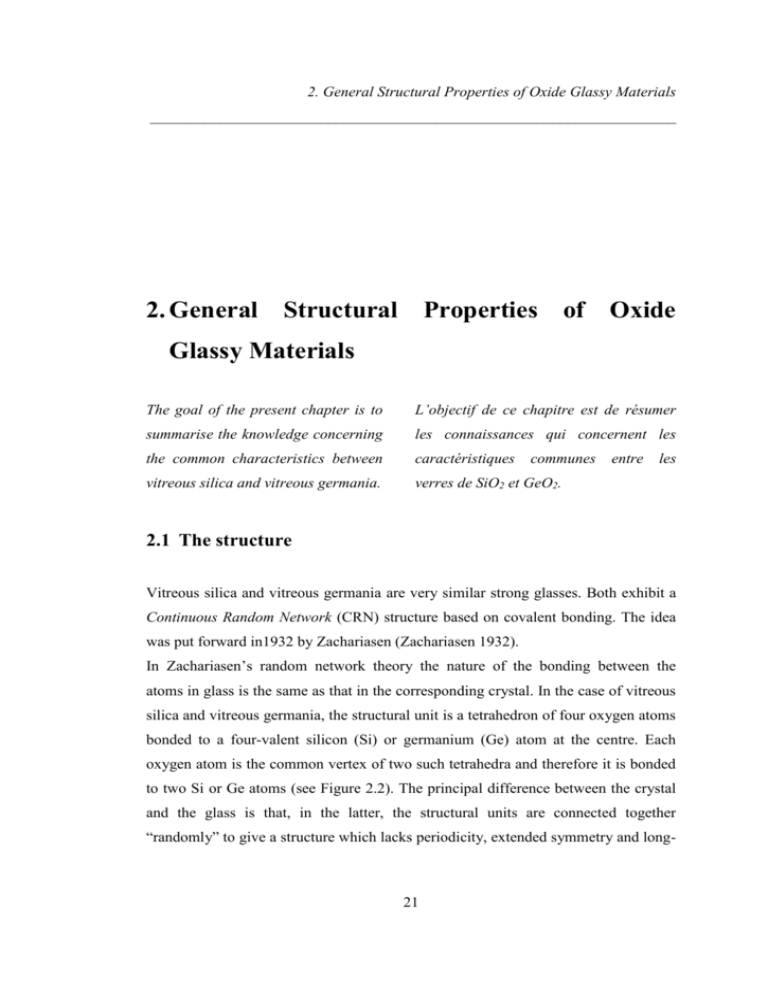
2. General Structural Properties of Oxide Glassy Materials ____________________________________________________________________ 2. General Structural Properties of Oxide Glassy Materials The goal of the present chapter is to L’objectif de ce chapitre est de résumer summarise the knowledge concerning les connaissances qui concernent les the common characteristics between caractéristiques vitreous silica and vitreous germania. verres de SiO2 et GeO2. communes entre les 2.1 The structure Vitreous silica and vitreous germania are very similar strong glasses. Both exhibit a Continuous Random Network (CRN) structure based on covalent bonding. The idea was put forward in1932 by Zachariasen (Zachariasen 1932). In Zachariasen’s random network theory the nature of the bonding between the atoms in glass is the same as that in the corresponding crystal. In the case of vitreous silica and vitreous germania, the structural unit is a tetrahedron of four oxygen atoms bonded to a four-valent silicon (Si) or germanium (Ge) atom at the centre. Each oxygen atom is the common vertex of two such tetrahedra and therefore it is bonded to two Si or Ge atoms (see Figure 2.2). The principal difference between the crystal and the glass is that, in the latter, the structural units are connected together “randomly” to give a structure which lacks periodicity, extended symmetry and long- 21 2. General Structural Properties of Oxide Glassy Materials ____________________________________________________________________ range order, as illustrated schematically in two dimensions in Figure 2.1 and in three dimensions in Figure 2.2 (Wright 1994). (a) (b) Figure 2.1: Zachariasen’s original random network diagram: SiO4 tetrahedra are joined at common oxygen atoms, for a crystal (a) and for the disordered system (b). Figure 2.2: Three-dimensional structure for vitreous silica. The silicon atom is in the middle of the SiO4 tetrahedron. 22 2. General Structural Properties of Oxide Glassy Materials ____________________________________________________________________ 2.2 Static and Dynamic Structure Factor When performing inelastic neutron scattering experiments, the Static Structure Factor for vitreous silica and vitreous germania can be determined and the same information can be obtained as from diffraction experiments. The procedure is explained later in more detail in Chapters 4 and 6. Figure 2.3 reports the neutron static structure factors S(Q) for vitreous silica (a) and vitreous germania (b) obtained from INS data taken at the IN4 spectrometer, using a incident wavelength of 1.53 Å which corresponds to an incident energy of about 35 meV. The dynamic range, which can be explored by using this set-up, is between 1 and 6.5 Å-1. S(Q) 3 (a) 2 1 0 (b) S(Q) 2 1 0 0 1 2 3 4 5 -1 Q [Å ] 6 7 Figure 2.3: Static structure factors S(Q) for vitreous silica (a) and vitreous germania (b), determined from neutron scattering data collected on IN4. 23 2. General Structural Properties of Oxide Glassy Materials ____________________________________________________________________ The structures observed in S(Q) are due to the structural short range ordering of the glasses. The origin of the main elastic feature, centred at about 1.5 Å-1, has been assigned to the spatial correlations induced by the presence in the network of ring like structures (Elliott 1991), and is usually referred to as First Sharp Diffraction Peak (FSDP). The dynamic structure factor S(Q, =BP) is represented in Figure 2.4. The frequency BP is the Boson Peak energy maximum at about 4 meV for vitreous silica and 3.5 meV for vitreous germania. (a) S(Q,BP) 0.10 0.05 0.00 (b) S(Q,BP) 0.10 0.05 0.00 0 1 2 3 4 5 6 7 -1 Momentum Transfer Q [Å ] Figure 2.4: Dynamic structure factors S(Q, =BP) for vitreous silica (a) and vitreous germania (b), determined from inelastic neutron scattering data collected on IN4, following the procedure described in Chapters 4 and 6. In S(Q, ω=ωBP) the inelastic contributions observed coincide approximately with the position of the peaks present in the static structure factors shown in Figure 2.3. 24 2. General Structural Properties of Oxide Glassy Materials ____________________________________________________________________ 2.3 The vitreous silica structure Among disordered systems, vitreous silica is a typical strong glass former and it has widely been studied both experimentally (by diffraction and inelastic scattering techniques) and numerically because it exhibits all the typical features of disordered materials. The distance Si–O, O–O and Si–Si and the coordination number have been obtained by x-ray diffraction studies (Wright 1994) and they are shown in Table 2.1. Si-O O-O Si-Si Maximum position 1.620.02 Å 2.60.03 Å 3.080.02 Å Peak Width 0.070.03 Å 0.100.04 Å 0.100.04 Å Coordination Number 4.10.4 Å 5.80.8 Å 3.40.4 Å Table 2.1 It is possible to divide the vitreous SiO2 structure in two “regions”: the first one is defined by the distance between an atom of silicon and the four atoms of oxygen around it, characterising the tetrahedra which build the structure of the system. The bond angle α, O-Si-O, is 109.7°, a larger value in comparison with the standard tetrahedral angle (109.47°). Figure 2.5: Definition of the angle in the three-dimensional network 25 2. General Structural Properties of Oxide Glassy Materials ____________________________________________________________________ The distance between the atoms of Silicon and between the structural units, characterise the second region. The bond angle β, Si-O-Si, is smaller than 180°, because the distance between the closer couple of Si atoms is smaller than twice the distance between the Si and the next-neighbouring oxygen atom. We need to define a third angle, the torsion angle , which characterises the orientation between the SiO4 tetrahedra connected in the network (Figure 2.5). The most important characteristics of vitreous silica and vitreous germania are listed in Table 2.2. Glass Melting Refraction Density Longitudinal Transversal Transition Temperature index Velocity Velocity Temperature Tm [K] n [g/cm3] vL vT [m/s] [m/s] Tg [K] v-SiO2 1473 2003 1.461 2.2 5970 3800 v-GeO2 853 1378 1.663 3.65 3637 2233 Table 2.2 Vitreous silica and vitreous germania are very similar to each other, but the latter is characterised by a lower sound velocity than the first one. The lower sound velocity makes possible the direct observation by Inelastic Neutron Scattering experiments of the dispersion relation over the (Q, )-region intermediate between hydrodynamic and single particle dynamics. REFERENCES ELLIOTT S.R., Phys.Rev.Lett. 67, 711 (1991). WRIGHT A.C., Journal of Non-Cryst. Solids 179, 84 (1994) ZACHARIASEN W. H. J. Am. Chem. Soc. 54, 3841 (1932). 26

